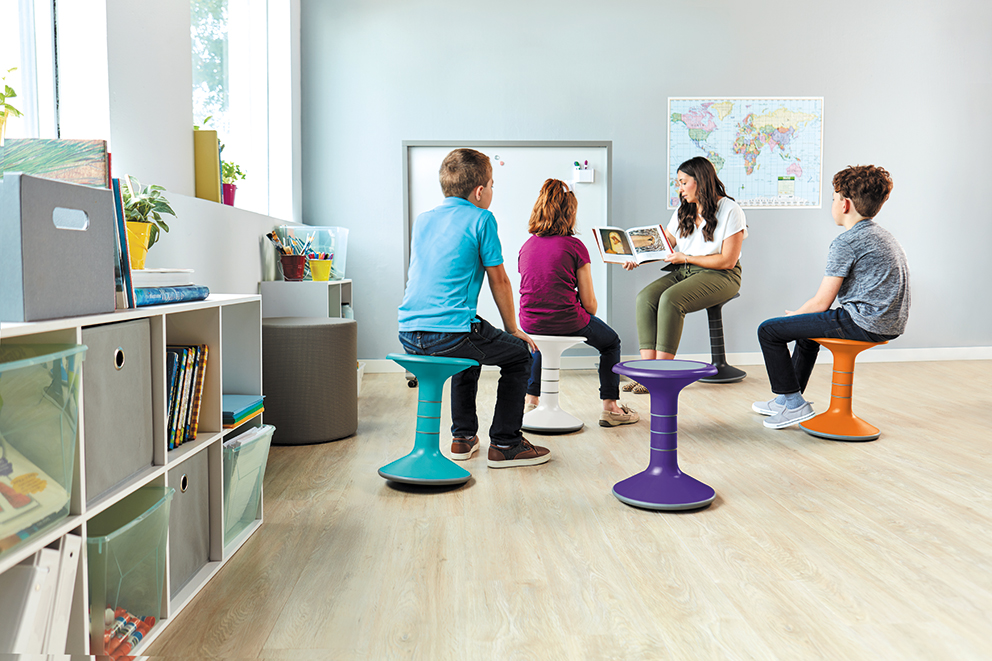
The furniture manufacturing group KI has some interesting thoughts on how to stimulate pupils’ brains through activity
There is a lot of research that shows us how movement is essential for the development of our sensory systems at a young age. Play and physical activity are essential for developing the senses and muscles we need to be in command of our bodies throughout our lives. In Valerie Strauss's article “Why so many kids can't sit still in school today” (08 July 2014, The Washington Post), paediatric occupational therapist Angela Hanscom discusses how a lack of movement has led to children having underdeveloped vestibular (balance) systems: "…when compared to children from the early 1980s, only one out of twelve children had normal strength and balance." This means that very few students have the physiological ability to sit still and pay attention, before even factoring in neurodivergence. Students might start to fidget and activate their brains, but this movement might be regarded as disruptive and unwelcome, so the student will curtail their own fidgeting or may even be reprimanded.
Here are some ways we can try to address the situation – so students can start to develop good habits and enjoy the benefits of movement immediately, and throughout their lives: 1. Before and/or after school: Encourage play. Playful, imaginative, fun, creative activity has countless benefits. It helps bodies and minds develop, fosters creativity and can help with socialisation when undertaken in groups. It also has a positive effect on performance long after 'play time' is over. Technology seems to be increasingly encouraging us all to be more sedentary, attentions fixed to our smartphones, smart TVs or laptop screens.
This makes real life, physical activities ever more important. Indoors or outdoors, depending on the space you have available, facilitate and support fun activities – sports, games, gardening, arts & crafts, fantasy, roleplay – whatever it might be, make it fun and interesting and the cognitive benefits will follow. 2. Between lessons: This one is more for schools to implement, but these days is also applicable to home-schoolers. Breaktimes and lunchtimes are important. Break up the day. Make children get up, move around, recharge their brains ready for the next part of the day where concentration and focus are required.
It is essential for their ability to pay attention, and retain information. What's more, these breaks during the day can further reinforce the benefits of play outside of structured learning times including creativity and social skills. 3. During lessons: Sitting still and paying attention might be what we are conditioned to do as students. But it is counterproductive. Movement 'turns on' the brain – so how do we encourage movement in the context of learning? Firstly, find ways to make the learning experience itself more active, less passive. In "Using actions to enhance memory: effects of enactment, gestures, and exercise on human memory", Christopher R Madan and Anthony Singhal describe the positive effects on cognition and memory derived from doing, rather than just reading or seeing. So lessons that encourage learner participation and demonstration can lead to better learning outcomes, whilst compounding the benefits of movement occurring outside the classroom. Provision of furniture, fixtures and fittings within the learning space can also contribute.
Moveable, even height-adjustable tables can make a space flexible and dynamic to support different activities through the day. Mixing up seating types can also allow students to find a preferred option, or even change throughout the day. Everything from exercise balls to wobble stools, height-adjustable chairs, chairs on castors, and more traditional seating all have a role to play. Excellent ergonomics are obviously important, but offering variety and freedom can really help to create a more inclusive, enjoyable and high-performing space.